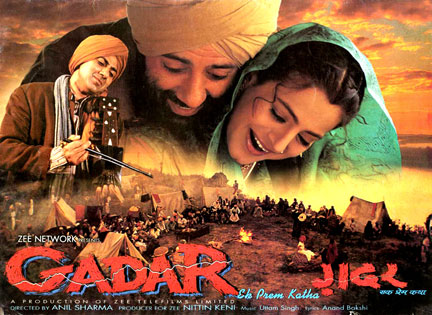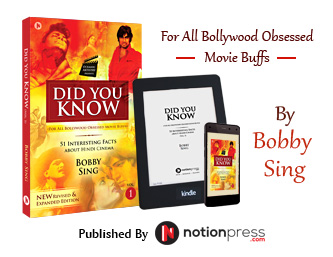
Released in 2001, Gadar – Ek Prem Katha created a storm at the box office breaking many previous records in terms of ticket sales and footfall in the theaters. Despite releasing along Lagaan – another successful milestone creation, Gadar won over the masses in an unprecedented manner, creating its own noteworthy stature in the history of Indian cinema.
As shared by the director Anil Sharma in one of his detailed interviews, the film’s storyline was actually conceived as a major sub-plot of his another venture being written on the plight of Kashmiri Pandits, aptly titled ‘Kashmir’. But while developing the same, he got deeply moved by the characters with the backdrop of partition and decided to present the tragic story as a complete film instead, scrapping the other project.
Adapting the events related with Boota Singh, he took inspiration from The Ramayan, presenting the saga in the new era with references to the two neighbouring countries. In his words, “After the Kargil conflict, what better Lanka would I find than Pakistan? And that's the reason why, at interval point, Amrish Puri takes Sakina back to Pakistan! Gadar was a modern depiction of a story deeply embedded in every Indian. The film had to be a hit."
The above rarely-revealed interpretation by the director actually enlightens us about a fact, that how many times we – as viewers – have no idea how a director had conceived his film, based on what kind of theme or basic plot! But then that’s what is called creative vision of a director and his depiction on screen, creating an entire world of his own.
Interestingly, just around the time Sharma was making his magnum opus, the same story of Boota Singh had already been adapted as a Punjabi film in India as Shaheed-E-Mohabbat Boota Singh produced by Manjeet Maan and directed by Manoj Punj, released in the year 1999. The film, featuring Gurdas Maan and Divya Dutta in the lead was written by Suraj Sanim and its soundtrack by Amar Haldipur also included a hit qawwali by Ustad Nusrat Fateh Ali Khan. It not only got appreciated in many film festivals in India and abroad but also won viewers’ hearts along with winning the National Award for the Best Punjabi Feature Film at the 46th National Film Awards.
However, the two original writers – who actually discovered the real life tragedy of Boota Singh, researched about it and included the same in their book – were not related to either cinema, India or Pakistan.
The reference of the story was actually taken from a widely appreciated and famous English book Freedom At Midnight, based on the horrifying events around partition of India and Pakistan in 1947-48. Co-written by Larry Collins and Dominique Lapierre, the book was published in the mid-seventies and included a detailed reference of the real-life story of Boota Singh, his love interest and how his unexpected death created a serious political scenario in Pakistan.
Interestingly, the tragic story also inspired an English film made in 2007 with the title of Partition directed by Vic Sarin. A decade later, Gurinder Chadha made her historical drama in English as Viceroy’s House in 2017 based on the events stated in two books, one of them being Freedom at Midnight. The film also got released in its Hindi dubbed version as Partition: 1947.
Coming back to Gadar and its on-location experience recalled by Anil Sharma, a major sequence of the film was shot on the same platform of Amritsar station where the actual train with the corpses had arrived in 1947. The station was given the authentic look of 1940s with all the advertisements and equipment replaced, besides shooting with the real crowd of locals and actors together recreating the dark-day of our history.
As stated by the director (post the scene got over), “One old Sikh gentleman was banging his head on the platform chair and howling”. When I told him “Papaji, the shot is over”, he looked up slowly with tears in his eyes and said, "It was more than 50 years ago when I was about 10 and I have myself witnessed this very same scene in real life. Today, it was as if everything was happening again in front of my old eyes”.
No response of any kind could have provided some comfort to the crying old man, as everyone duly understood what his few words meant to him, bringing back those ugly memories after more than half a century. Such was the impact of the realistic scene shot on the witnesses there on the location.
A similar impact was seen again as the film got released in the theaters. Today, in the present digital era, that euphoria can easily be summed up as the sheer magic of cinema.
Bobby Sing
bobbytalkscinema.com
NOTE : The article was first published in THE FREE PRESS JOURNAL Newspaper (Mumbai Edition) on 7th February 2021.
Note : The write-up is a chapter shared from my upcoming book releasing soon. So any additions, rectifications suggested by friends are welcome to make it better.
----------
 For more such interesting articles on lesser known facts on Hindi Cinema, do try DID YOU KNOW
For more such interesting articles on lesser known facts on Hindi Cinema, do try DID YOU KNOW Series by
Bobby Sing available in both
Book and
E-book form
.
Also available
at Notionpress and Flipkart stores (in India)
The book is now also available in Hindi titled
ITNA TO YAAD HAI MUJHE published by Prabhat Prakashan


 For more such interesting articles on lesser known facts on Hindi Cinema, do try DID YOU KNOW Series by Bobby Sing available in both Book and E-book form.
For more such interesting articles on lesser known facts on Hindi Cinema, do try DID YOU KNOW Series by Bobby Sing available in both Book and E-book form.